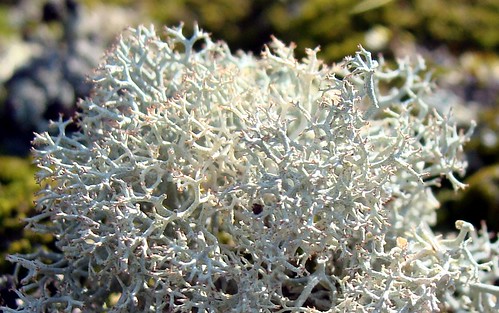True, there are some nearly straight lines in natural objects. Some tree trunks are almost perfectly straight. Still water has a flat surface, a straight line expanded to two dimensions, as it were. Salt crystals are sometimes nearly perfect cubes, or, at least, they often have one or more flat surfaces. Some leaf veins are almost perfectly straight. But these examples are rare.
Spider webs do have what appear to be straight lines, but they usually don't go very far before joining with another line, which goes in a different direction, and, like power lines, the threads usually sag in the middle. I am not sure that there are any really straight lines in the photo above. (The photo is from my Flickr photostream. If you want to see a larger version, go here.)
Covalent bonds, such as the 4 bonds that Carbon atoms can form

are depicted as straight, as in the image of cyclohexane, above, where the dark gray balls represent carbon atoms, and the rods between the balls represent covalent bonds. But the angles of the bonds are such that, even in this model, the straight lines can not continue in the same direction. Besides, the bonds aren't really little rods, any more than the atoms are little spheres. And, even if they were little straight rods, they are very short -- just the distance between two adjacent atoms in a tiny molecule.
The two examples above, and some tree trunks, are about as close to really straight lines as you are going to find, in natural objects. Look, for example, at the trees and leaves in the first photo, or at almost any natural scene. You will see all sorts of shapes, many of them difficult to describe, but you will almost never see straight lines.
Why is that? I don't know. But this fact suggests that it is very difficult to grasp nature clearly. In a way, our use of straight lines, angles, flat surfaces, and curves, in the things we build for ourselves, is a reflection of our power over such artifacts. But we have much less power over nature -- we can't create it. Its shapes are too complicated for us to easily duplicate, and comprehend.
The word, "straight," is used several times in the Bible. Of the twelve versions that the Blueletter Bible offers, the New International Version has the most occurrences, 40. Here they are.
I am not sure that any of these 40 refer to a straight line, as such. Most of them are used in the sense of going straight toward some destination.
Here's one instance of the use of "straight" in the Bible:
Matthew 3:3 For this is he who was spoken of by Isaiah the prophet, saying,
“The voice of one crying in the wilderness,
make ready the way of the Lord.
Make his paths straight.” (This is referring to Isaiah 40:3, which uses much the same wording.)
Did the people of Bible times understand the concept of straight lines, or straightness? Surely they did. In Acts 9:11, a street in Damascus is called Straight Street. 2 Kings 21:13 uses the concept of a plumb line as a measure of straightness.
To sum it up, God, and God's nature, are more complex than we often like to make things. But that is not to say that God doesn't understand our simple patterns and constructions, often with straight lines all over the place. He does. He made straightness possible. We should see beauty in the seemingly complex, and difficult to describe, shapes that we find in nature, such as the lichen below:
(Larger sizes here.)
Thanks for reading! Keep yourself straight, but appreciate complexity.




2 comments:
"Poems are made by fools like me
But only God can make a tree."
That's true, FancyHorse.
Thanks.
Post a Comment